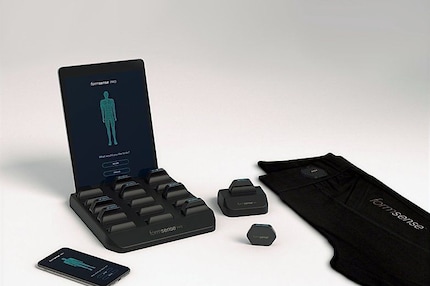
Smart underwear from Formsense makes athletes transparent

The start-up Formsense has developed sportswear that measures movement and detects injury risks. Collecting biomechanical data in real time could be the next big thing in competitive sport - and then conquer the mass market.
What do you love about sport? It's often coincidences, imponderables and crazy twists and turns that create drama and thrill the crowds. Coaches and athletes, on the other hand, hate them. Legions of competitive athletes, scientists, scouts and computer scientists are working on eliminating elements of chance and optimising performance. Yet it wasn't so long ago that individual load control was a foreign concept in team sports.
Today, every metre and every heartbeat is measured. Heart rate belts, GPS trackers and wearables are standard even for recreational athletes and the development continues. Sensors in the shoe analyse the running style, the leg press acts like an artificial muscle and data analysts try to uncover the secret of success in team sports. Anyone familiar with the book Matchplan, which is well worth reading, will have an idea of where football is heading. And will realise that the actual performance does not always match the viewer's perception. It can be seen in the big picture, in the influence of actions on the game. And on a smaller scale, in the elegance and efficiency of an athlete's movements. Measuring them, optimising processes and identifying injury risks is relatively time-consuming.
Smart shirts and shorts instead of studio conditions
Motion analyses are often a matter for the laboratory or studio, where motion capture methods with reflective markers on the body are used to create a 3D model, for example. Messi's feints or Federer's forehand can be captured in this way and analysed for their magic content. EA Sports does this with professionals to animate realistic movements in FIFA games. Formsense wants to make similar data available in real time and without disruptive accessories.
Our body has proprioceptors in the muscles, through which we perceive the position and movement of the body in space and which, among other things, transmit information on muscle tension to the brain. The 20 sensors in the company's shirts and shorts are designed to do something similar - with the difference that they send the collected information to the cloud and iPad rather than to the brain. This means that they can be easily analysed by specialists during training, before, during or after a competition. This freedom makes Formsense interesting.
Tests with Premier League, NBA and MLS clubs
NBA player Mason Plumlee is one of the investors. The start-up is supported as one of San Diego's "Cool Companies" and has been testing its smart underwear in cooperation with Premier League, NBA and MLS clubs since 2017.
The team led by founder Nathan Ramasarma, who previously co-developed one of the first smartwatches at Qualcomm, designed the sensors themselves from scratch. Combined with adaptive algorithms, they should be able to recognise individual exercises and individual problems. The compression shirts and trousers are now ready for the market - and of course "Formsense Pro" is initially aimed at professional athletes. The smart items are said to be even lighter than standard compression underwear on the market and will initially be used by Major League Soccer teams.

Source: Twitter/@formsenseHQ
The mass market is the long-term goal if the technology proves itself. This would open up new possibilities in training management, prevention and rehabilitation. Trainers and therapists would not only be able to better assess the quality of exercise execution and optimise it by making corrections, they would also be actively warned if an injury is imminent due to the movement patterns. All of this could be realised with relatively little effort for entire teams or larger training groups - the digital clone on the display makes it possible.


Simple writer and dad of two who likes to be on the move, wading through everyday family life. Juggling several balls, I'll occasionally drop one. It could be a ball, or a remark. Or both.
From the latest iPhone to the return of 80s fashion. The editorial team will help you make sense of it all.
Show all